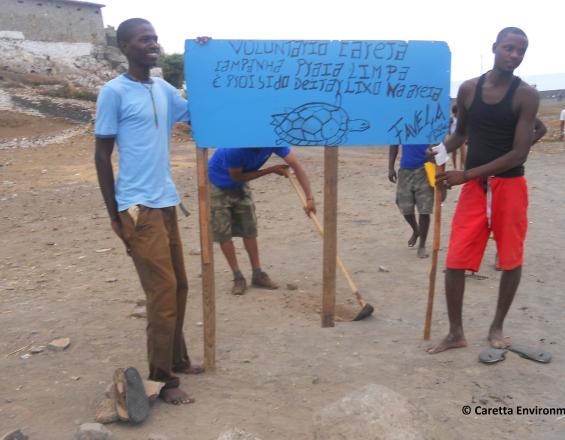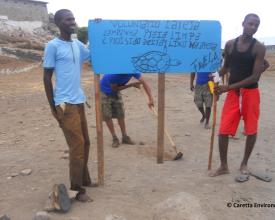
Engaging the community in endangered species protection
Full Solution

Launch of the caretta project.
Caretta Environmental Association
Santa Cruz is a coastal community with about 26 thousands inhabitants with a strong past history of sea turtle slaughter and consumption as well as marine degradation. This solution addresses raising awareness and effectively engaging the community in endangered species protection and marine conservation.
Last update: 30 Sep 2020
5542 Views
Context
Challenges addressed
• Slaughter and consumption of sea turtle meat and eggs.
• Discharge of plastic into the ocean by fishermen and residents.
Location
Santa Cruz, Cape Verde
West and Central Africa
Process
Summary of the process
The building blocks are implemented in a logical and strategic sequence in order to ensure taking full advantage of the lesson learned and transfer it to the next one. The people involved in the solution are taken from one building block to another and accumulate lessons learned. The building block interacts with one another by strengthening the lessons learned to the next one.
Building Blocks
Success through involvement of local communities
The community is divided into 2 groups, children and adults. The children regularly participate in beach cleaning campaigns on weekends and help taking sea turtles hatchlings to the sea. Adults participate in harder work such as beach night patrols and collecting plastic from the sea.
Enabling factors
Some members of the community are part of the solution. It facilitates carrying messages to the community and solves problems. By having a person from the community on our side inspires more confidence and brings more people together.
Lesson learned
Any environmental project cannot succeed without the involvement of the local community. They are the people who better know their community. By engaging them you make sure the project continues in the future and is passed to the next generations. They should be involved in decision making, planning and the implementation of actions.
Integration of fisherfolk
Fisherman are addressed in their work place in informal conversations aiming to raise awareness on the impacts of their behavior. They are also regularly invited to participate in training sessions in which scientific data is shared. This expresses the need of changes in their behavior. We share scientific data such as conservation status of loggerhead turtles as an endangered species due to plastic ingestion, ocean pollution and other human actions (UICN). We also share information such as the prediction by the Ellen MacArthur Foundation and the World Economic Forum that “there will be more plastic than fish in the sea by 2050” if we do not change our behavior.
Enabling factors
Fishermen are simple and humble people and can be easily accessed as they are members of the same community as the solution providers. After gaining their trust they become good solution partners.
Lesson learned
Local fishermen are very knowledgeable people and their experiences are very useful and should be taken into account. Their daily activities provide them useful information that has been used to improve the solution. They know where the threats are stronger and where sea turtles are more vulnerable to hunting. Their knowledge has also assisted us in determining the best time of the day the sea turtles lay eggs, the main spots and the period of hatchings.
Community beach clean-ups
We regularly organize beach cleaning-up campaigns at weekends, especially during vacation periods with students, to collect plastic bags and garbage. We communicate with the community through the local community radio and public events.
Enabling factors
Creating a partnership with the environmental department of the city hall to take waste to its final destination.
Lesson learned
The involvement of the community in solving their own problems is very inspiring and positively contagious. It improves the impact. However, I would advice a very efficient communication in order to not leave anyone out. All members of the community should feel useful in the process.
Community beach patrols
The beach patrols occur at night to collect data and make sure the female turtles are not disturbed and slaughtered. The patrols are undertaken by 2 to 4 community persons groups which are led by a more experienced person of the Caretta Association. We collect data such as animal length, width, presence of external parasites, injuries, and localization of the nest. The data is collected and entered in a form to produce a further report and publication. Our constant presence on the beach is also a message to move away the poachers.
Enabling factors
Proximity of the community to the beach. Aroused curiosity to see a sea turtle laying eggs.
Lesson learned
This hands-on activity provided the community a different perspective and developed a sense of belonging. Before that they should all go through a training in order to make sure the presence of not experienced people does not become a threat.
Public rewards for best actions
All work is recorded in photos and videos and disseminated on social media. The best actions and practices are awarded in public events. The association will meet at its General Assembly and each member will vote for a person to be named the volunteer of the year. The person with the most votes will be publicly awarded and reported in local and national media.
Enabling factors
Existence and partnership with a local community Radio station.
Lesson learned
By publicly rewarding a person you motivate them and inspire others to follow the same example. You have to make sure the process is clear and fair to avoid any discontent.
Impacts
• Reduction of garbage dump and plastic at sea.
• Reduction of sea turtle death due to plastic Ingestion.
• Increase of sea turtles nesting on the beach.
• Fishermen became part of the solution and their children are prepared to become better citizens.
Beneficiaries
The local community and the entire planet as we all depend on a healthy oceans.
Story
“Before 2012 I used to witness slaughter and consumption of sea turtle meat and eggs, discharge of plastic in the sea by fishermen and residents. As a young biologist I am passionate about nature and the marine Environment. I was motivated and inspired to do whatever necessary to reverse the situation. I joined a group of young people who had the idea of creating an organization to raise awareness among the community and make them part of the solution. We created “Caretta Association” for the protection of sea turtles and the marine environment. The project is currently implemented in the main and largest island of Cape Verde. Since the implementation of the project there has been a reduction of dead sea turtle carcasses found. Many people have engaged and some have returned to the sea animals that were kept in captivity.” (Jaquelino Lopes Varela)
